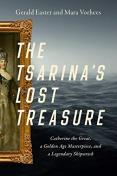BKMT READING GUIDES
The Tsarina's Lost Treasure: Catherine the Great, a Golden Age Masterpiece, and a Legendary Shipwreck
by Mara Vorhees Gerald; Easter
Hardcover : 400 pages
1 club reading this now
0 members have read this book
Introduction
On October 1771, a merchant ship out of Amsterdam, Vrouw Maria, crashed off the stormy Finnish coast, taking her historic cargo to the depths of the Baltic Sea. The vessel was delivering a dozen Dutch masterpiece paintings to Europe’s most voracious collector: Catherine the Great, Empress of Russia. Among the lost treasures was The Nursery, an oak-paneled triptych by Leiden fine painter Gerrit Dou, Rembrandt’s most brilliant student and Holland’s first international superstar artist. Dou’s triptych was long the most beloved and most coveted painting of the Dutch Golden Age, and its loss in the shipwreck was mourned throughout the art world.
The shipwreck Vrouw Maria became a maritime legend, confounding would-be salvagers for more than two hundred years. Finally, in July 1999, a daring Finnish wreck hunter found Vrouw Maria, upright on the sea floor and perfectly preserved. The Tsarina’s Lost Treasure masterfully recounts the fascinating tale of the Vrouw Maria—her loss and discovery—weaving together the rise and fall of the artist whose priceless masterpiece was the jewel of the wreckage.
In this riveting history and maritime adventure, Gerald Easter and Mara Vorhees bring to vivid life the personalities that drove (and are still driving) this compelling tale. The book evokes Robert Massie’s depiction of Russian high politics and culture, Simon Schama’s insights into Dutch Golden Age art history, and Gary Kinder’s spirit of adventure on the beguiling Archipelago Sea.
Editorial Review
No Editorial Review Currently AvailableExcerpt
Prologue: The WreckThe approaching vessel struck sail before the bronze battery, reminding all captains that further passage required payment to the Danish king. Through sallow mist the towers of Castle Kronborg loomed. The citadel of Elsinore, home to Hamlet’s ghosts, and gateway to the Baltic Sea. ...
Discussion Questions
1. Why was Gerrit Dou so revered in the 17th and 18th centuries, and then largely forgotten in the 19th century? What was the role of individual critics and scholars, versus changing tastes of the public? Would his legacy be different if his masterwork had survived the shipwreck? Can Dou make a true comeback in the 21st century, considering his very realist style?2. What makes Dou’s triptych, The Nursery, so special? Does the symbolism of the objects in the painting enhance the quality of the artwork? More broadly, what criteria do we use to judge art and how has this changed over time?
3. One of the recurring themes in The Tsarina’s Lost Treasure is the interplay between politics and art. What are some ways that art and culture influenced politics (and vice versa), particularly during the 18th and 19th centuries? What made a ruler like Catherine or Frederick the Great “enlightened” and what did it mean for the politics of their countries?
4. Why were art critics and others upset when Gerrit Braamcamp’s collection was broken up and sold to buyers across Europe? Why do you think Braamcamp specified that everything should be auctioned to the highest bidder? Do societies have an obligation to protect such things as a part of their national heritage?
5. Why is Rauno so successful as a wreck hunter? How is his strategy for finding the Vrouw Maria different from others who had tried before him?
6. Why does conflict arise between Rauno and the Finnish National Board of Antiquities (NBA) when it seems that they should share the same interests? Was the lawsuit over the Vrouw Maria inevitable, considering the contradictory laws?
7. Considering the many claimants to the Vrouw Maria and her cargo, whose claim do you think has the most legitimacy (logically, not necessarily legally)? Whoever the legitimate claimant is, do they have any obligation to the other parties? What is it — to protect, study, salvage, or otherwise act on the shipwreck? Why is the NBA so resistant to excavating or salvaging the Vrouw Maria, or even exploring the possibility?
8. Why do you think is in situ preservation trending in archeology in general and in marine archeology in particular? What are the challenges that come with raising shipwrecks? What would be the benefits of raising the Vrouw Maria? How could Finland best make use of this resource?
9.The Vrouw Maria is a Dutch ship that had a Danish captain, carrying Dutch and other international cargo to a Russian destination. It happened to sink in Finnish waters. Is this shipwreck part of Finnish heritage? Is this question relevant to the fate of the shipwreck? Should it be?
10. Evidence and art experts suggest it is unlikely that the triptych and the other paintings are in good condition after spending 200-plus years underwater. Does this influence whether they should be investigated and/or excavated? As a society, do we have a moral or cultural obligation to investigate? And if they are destroyed, do they still have some value – monetary or otherwise?
11. Have you ever been to a shipwreck museum? Visited ancient ruins? Admired archeological artifacts in a broken or even unrecognizable state? What is the appeal of such relics that are arguably just detritus? Why are we intrigued by wrecks and ruins?
Book Club Recommendations
Recommended to book clubs by 0 of 0 members.
Book Club HQ to over 88,000+ book clubs and ready to welcome yours.
Get free weekly updates on top club picks, book giveaways, author events and more








